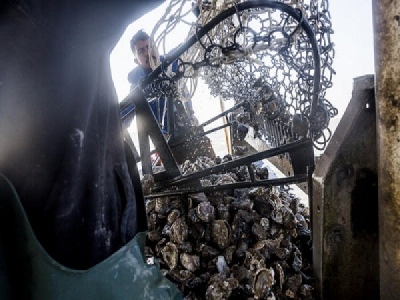
Posted on December 12, 2017
By John Burnett, KUOW
Hurricane Harvey caused catastrophic damage in Houston, but the historic deluge also brought calamity to the Houston Ship Channel and Galveston Bay. The aftermath of the storm threatens two vital industries — one mammoth and ironclad, the other small and slimy: shipping and oysters.
Fire Boat One cruises down the Houston Ship Channel — one of the hardest working waterways in America.
On either side of the channel are grain silos, warehouses and storage tanks for products ranging from petroleum to molasses. Giant container ships refuel for their voyages back across the Atlantic Ocean. Tugboats are nudging rusty barges in every direction.
“You look out here today, it’s a nice calm day, except that we’re draft restricted,” says Mark Vincent, director of channel development at the Port of Houston. The term means that the channel is too shallow for ship traffic in certain places.
Houstonians were relieved when floodwaters drained from the city’s bayous into the ship channel, then the bay, and finally into the Gulf. But that was just the beginning of Vincent’s troubles.
“This storm event was absolutely extraordinary,” he says, riding on the bow of the fire boat. “We estimate millions of tons of sediment were carried into the ship channel, all of which need to be removed over time in order to enable safe navigation of our ships.”
The Port of Houston ranks as the busiest port in the nation, and first in foreign waterborne tonnage. It serves the largest petrochemical complex in America.
But these shoals created by Harvey mean that cargo-laden ships run the risk of running aground because they sit so low in the water.
“And we have many, many ships that might have to plan to bring less cargo and over time bring more ships to Houston simply because we’re draft restricted. And that’s inefficient, and ultimately it’s going to cost consumers money,” Vincent says.
Enter the dredges. These ungainly workhorses suck mud from the murky floor of the channel 24/7. More than a century ago, dredge boats scooped out an underwater trench 52 miles long — down Buffalo Bayou and across shallow Galveston Bay — to create the Houston ship channel. Ever since, nature has been trying to fill it back in. The dredges have to maintain the channel at a depth of 45 feet for the deep-draft ships delivering Volkswagens, wind turbine blades and other heavy cargo to the seaport.
“We do this over and over again. Our district’s been dredging for over a hundred years. This is what we do,” says Tricia Campbell, operations manager with the Galveston District of the Army Corps of Engineers.
Every year for the past three years, huge floods in Houston have forced emergency dredging. In fact, the workboats were still scooping up silt from earlier storms when Harvey struck.
With more monster storms hitting Houston, the port lobbies Congress to give the Corps additional funding to maintain the ship channel. Campbell concedes they could use more dredges.
“Well, we can definitely do more than what we’re already doing,” she says. “If we had more funding we could put out more contracts, more dredging. But at this time we work with what we get.”
After Harvey’s 4 feet of rain fouled up the ship channel, it poured into Galveston Bay.
“It essentially turned Galveston Bay into a freshwater lake,” says Bob Stokes, president of the Galveston Bay Foundation, “and many of our species were impacted negatively by all that freshwater. The one that’s going to have the longest term impact is our oysters.”
Galveston Bay is one of the country’s major oyster fisheries. Oystermen are reporting a massive kill-off of the delectable mollusk — which, here on the Gulf Coast, is dipped in red cocktail sauce mixed with horseradish and a dash of Tabasco, and eaten with a crisp saltine.
Raz Halili — co-owner of Prestige Oysters — says when he came to his company’s docks after the storm, the bay had so much muddy freshwater it looked like a melted chocolate bar. Not good for the oysters.
“They need brackish water, they need that mixture of freshwater and saltwater to really thrive. But when you get too much of one thing, it can be bad.”
It was supposed to be a banner year for Galveston Bay oysters. They’d come back strong from successive bad seasons brought on by earlier storms. Harvey has set back the harvest again.
An oyster boat named the Hustler sidles up to the dock, as white pelicans dive for lunch out on the bay. Mexican deckhands heave 100-lb. sacks of the bivalves onto a conveyor belt.
Arsem Hyseni — an immigrant from Kosovo, just like the owners of Prestige Oysters — steps off the boat after six hours on the water.
“They (oysters) are hurt pretty bad. In some places, 100 percent die. Some places we working now it’s 40 to 50 percent die. Some places better. But hit pretty hard this time.”
The oysters will eventually recover, but in the near term, prices on the half-shell will jump. The dredges will work to deepen the ship channel, but in the meantime it will make shipping more expensive. The costs from Hurricane Harvey keep piling up.
Source: KUOW





